A Case Study: Cost Leadership's Influence on Tesco UK's Profitability
VerifiedAdded on 2019/12/03
|46
|13329
|164
Report
AI Summary
This report investigates the influence of cost leadership strategies on the profitability of Tesco, a major player in the UK retail sector. The study begins with an introduction to the concept of cost leadership and its significance in a competitive market, followed by a review of relevant literature, including cost leadership models and strategies, and factors affecting profitability. The research employs an interpretivism approach, analyzing secondary data to assess Tesco's strategies and their impact. The analysis includes thematic analysis of Tesco's market share, value chain, and competitive strategies. The report addresses research questions concerning Tesco's cost leadership strategies, factors affecting profitability, the effectiveness of these strategies, and recommendations for improvement. The findings provide insights into Tesco's performance, challenges, and strategic adaptations, with a focus on the application of Porter’s generic strategies, value chain analysis, and other related models. The report concludes with recommendations for Tesco to enhance its profitability through improved cost leadership strategies.
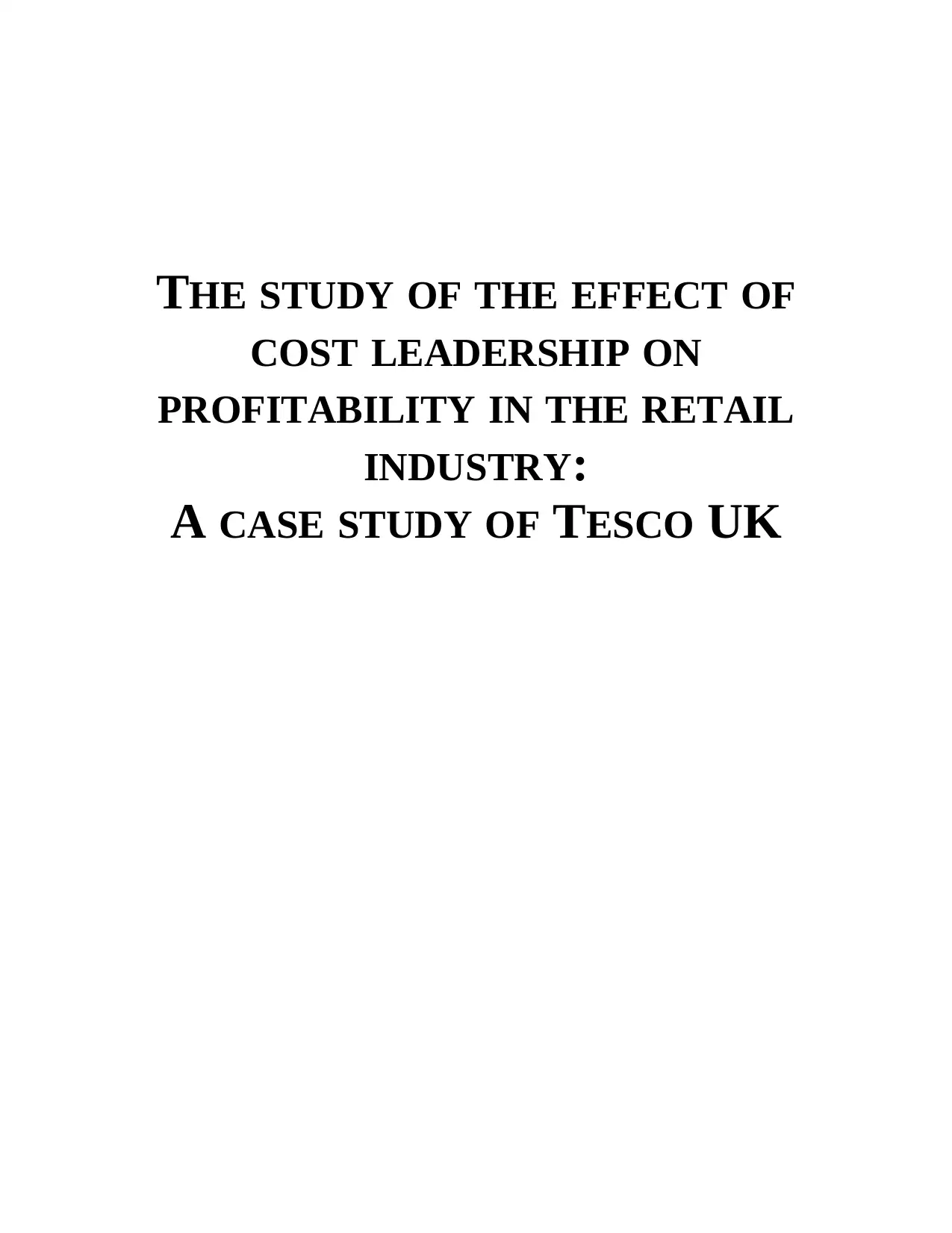
THE STUDY OF THE EFFECT OF
COST LEADERSHIP ON
PROFITABILITY IN THE RETAIL
INDUSTRY:
A CASE STUDY OF TESCO UK
COST LEADERSHIP ON
PROFITABILITY IN THE RETAIL
INDUSTRY:
A CASE STUDY OF TESCO UK
Paraphrase This Document
Need a fresh take? Get an instant paraphrase of this document with our AI Paraphraser
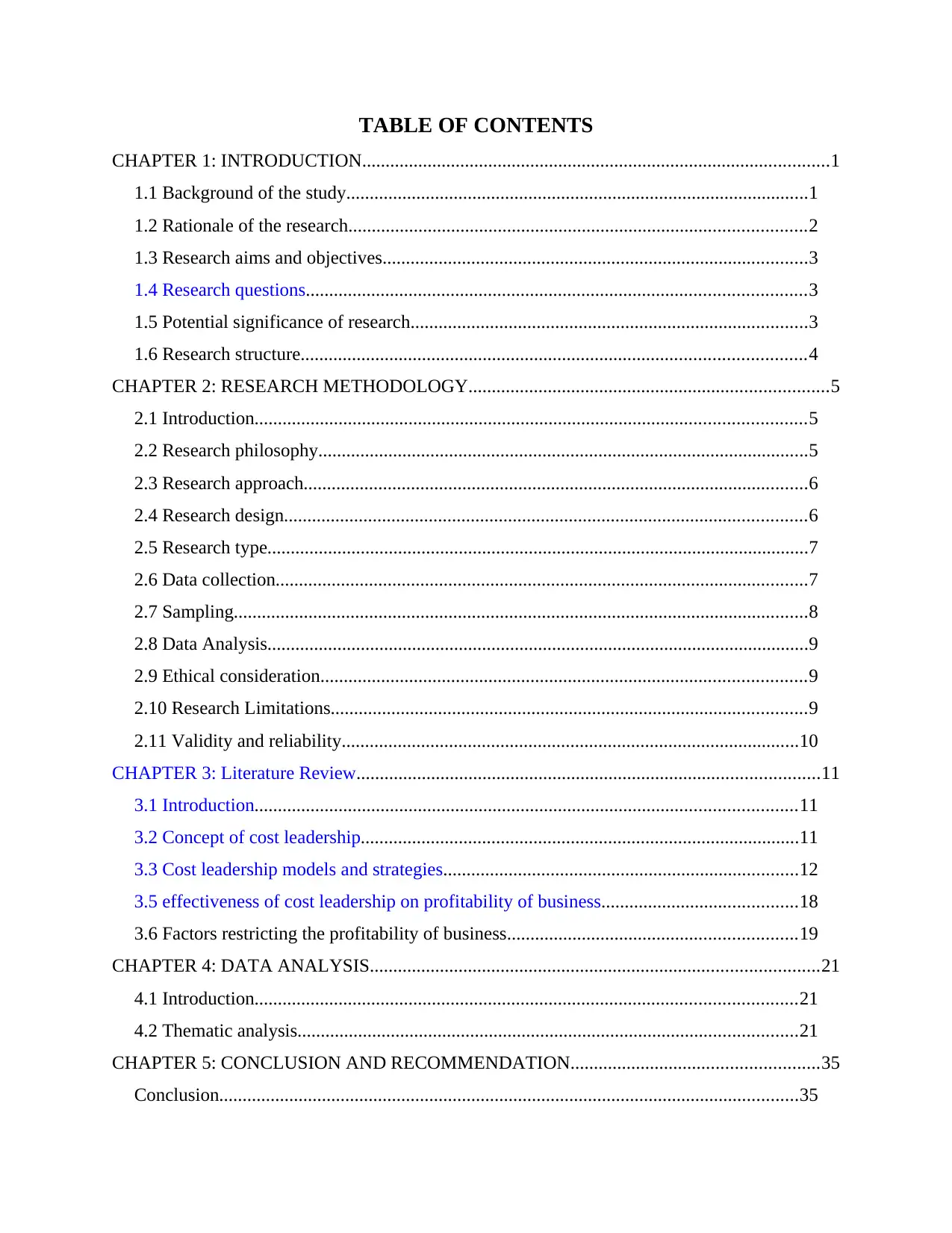
TABLE OF CONTENTS
CHAPTER 1: INTRODUCTION....................................................................................................1
1.1 Background of the study...................................................................................................1
1.2 Rationale of the research..................................................................................................2
1.3 Research aims and objectives...........................................................................................3
1.4 Research questions...........................................................................................................3
1.5 Potential significance of research.....................................................................................3
1.6 Research structure............................................................................................................4
CHAPTER 2: RESEARCH METHODOLOGY.............................................................................5
2.1 Introduction......................................................................................................................5
2.2 Research philosophy.........................................................................................................5
2.3 Research approach............................................................................................................6
2.4 Research design................................................................................................................6
2.5 Research type....................................................................................................................7
2.6 Data collection..................................................................................................................7
2.7 Sampling...........................................................................................................................8
2.8 Data Analysis....................................................................................................................9
2.9 Ethical consideration........................................................................................................9
2.10 Research Limitations......................................................................................................9
2.11 Validity and reliability..................................................................................................10
CHAPTER 3: Literature Review...................................................................................................11
3.1 Introduction....................................................................................................................11
3.2 Concept of cost leadership..............................................................................................11
3.3 Cost leadership models and strategies............................................................................12
3.5 effectiveness of cost leadership on profitability of business..........................................18
3.6 Factors restricting the profitability of business..............................................................19
CHAPTER 4: DATA ANALYSIS................................................................................................21
4.1 Introduction....................................................................................................................21
4.2 Thematic analysis...........................................................................................................21
CHAPTER 5: CONCLUSION AND RECOMMENDATION.....................................................35
Conclusion............................................................................................................................35
CHAPTER 1: INTRODUCTION....................................................................................................1
1.1 Background of the study...................................................................................................1
1.2 Rationale of the research..................................................................................................2
1.3 Research aims and objectives...........................................................................................3
1.4 Research questions...........................................................................................................3
1.5 Potential significance of research.....................................................................................3
1.6 Research structure............................................................................................................4
CHAPTER 2: RESEARCH METHODOLOGY.............................................................................5
2.1 Introduction......................................................................................................................5
2.2 Research philosophy.........................................................................................................5
2.3 Research approach............................................................................................................6
2.4 Research design................................................................................................................6
2.5 Research type....................................................................................................................7
2.6 Data collection..................................................................................................................7
2.7 Sampling...........................................................................................................................8
2.8 Data Analysis....................................................................................................................9
2.9 Ethical consideration........................................................................................................9
2.10 Research Limitations......................................................................................................9
2.11 Validity and reliability..................................................................................................10
CHAPTER 3: Literature Review...................................................................................................11
3.1 Introduction....................................................................................................................11
3.2 Concept of cost leadership..............................................................................................11
3.3 Cost leadership models and strategies............................................................................12
3.5 effectiveness of cost leadership on profitability of business..........................................18
3.6 Factors restricting the profitability of business..............................................................19
CHAPTER 4: DATA ANALYSIS................................................................................................21
4.1 Introduction....................................................................................................................21
4.2 Thematic analysis...........................................................................................................21
CHAPTER 5: CONCLUSION AND RECOMMENDATION.....................................................35
Conclusion............................................................................................................................35
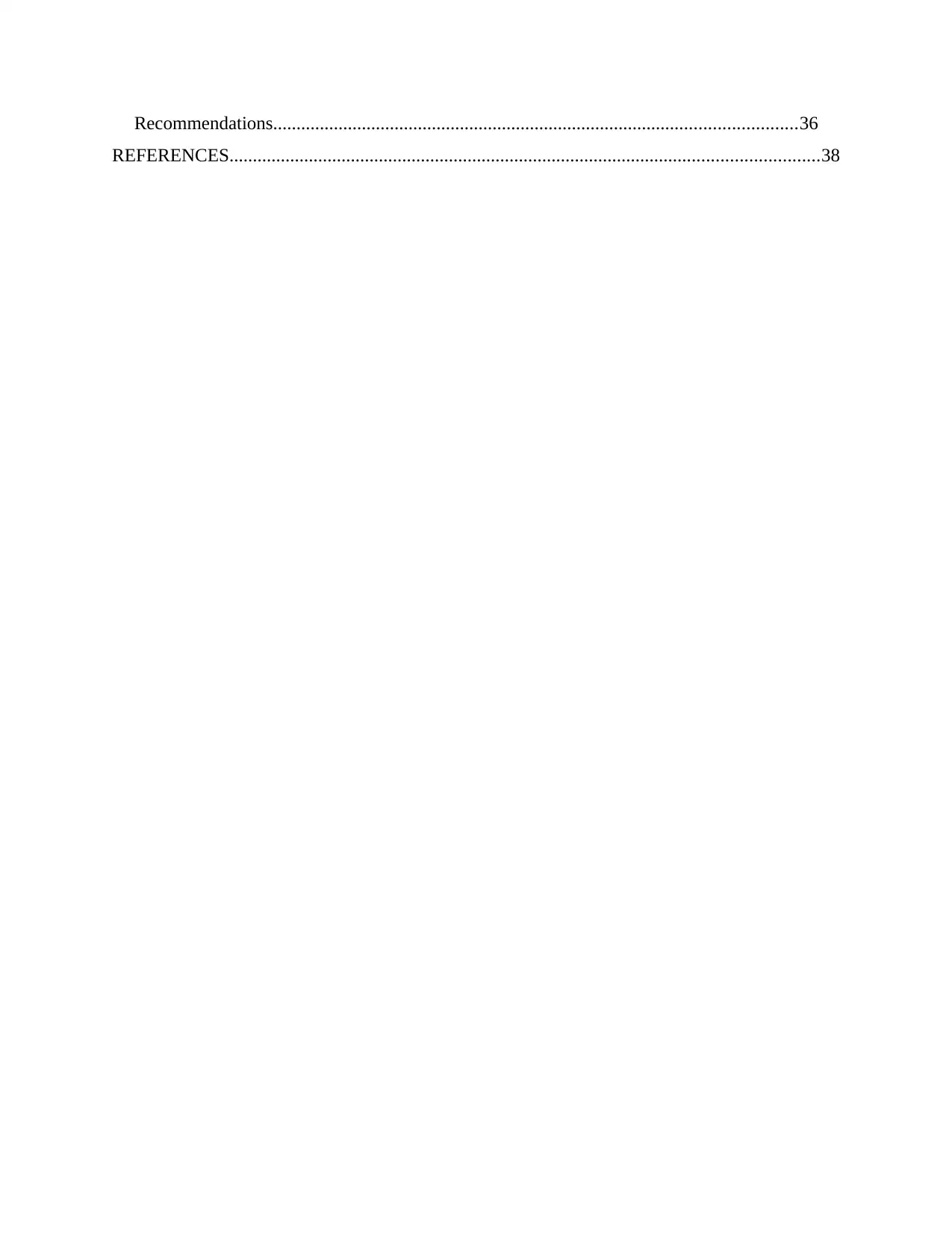
Recommendations................................................................................................................36
REFERENCES..............................................................................................................................38
REFERENCES..............................................................................................................................38
⊘ This is a preview!⊘
Do you want full access?
Subscribe today to unlock all pages.

Trusted by 1+ million students worldwide
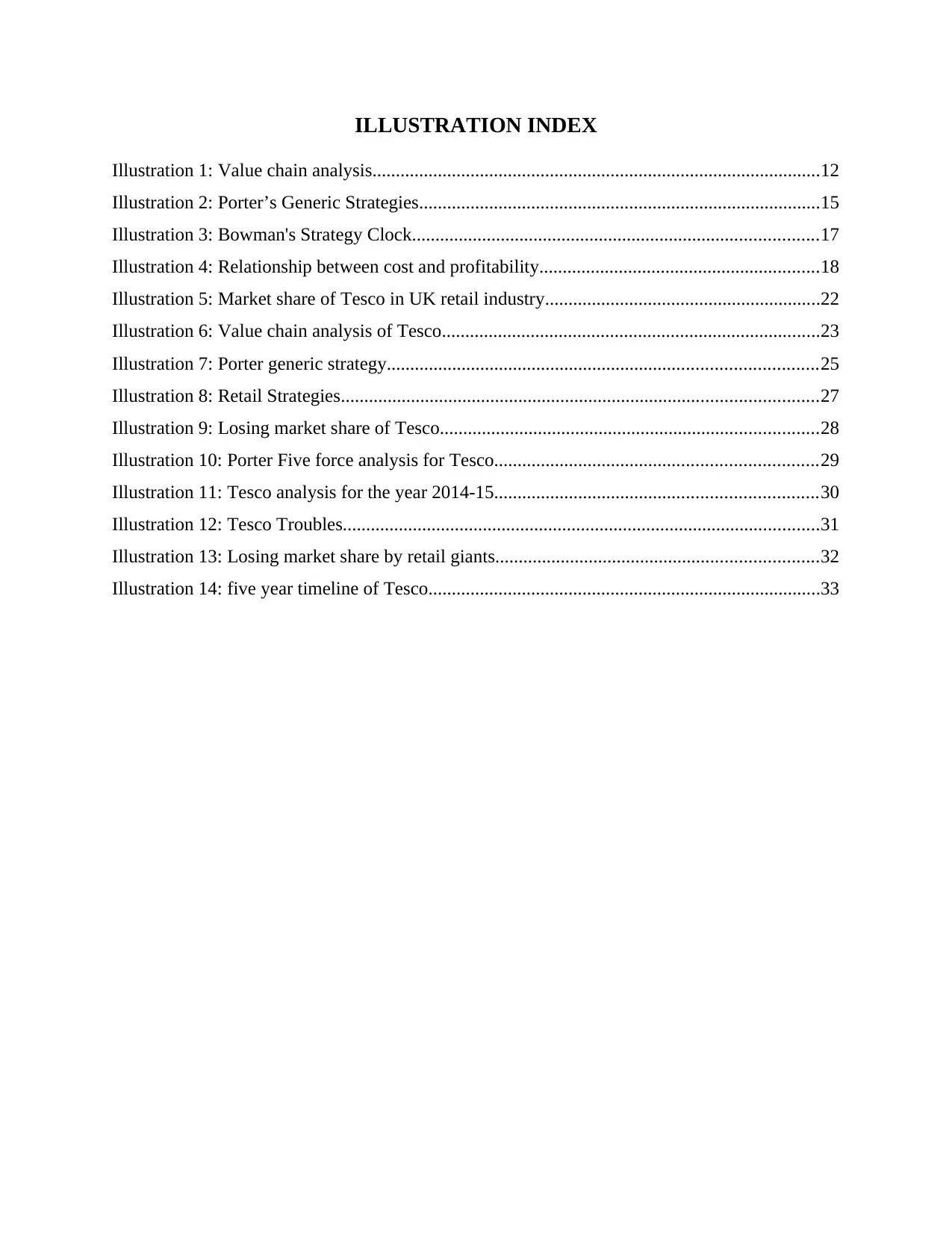
ILLUSTRATION INDEX
Illustration 1: Value chain analysis................................................................................................12
Illustration 2: Porter’s Generic Strategies......................................................................................15
Illustration 3: Bowman's Strategy Clock.......................................................................................17
Illustration 4: Relationship between cost and profitability............................................................18
Illustration 5: Market share of Tesco in UK retail industry...........................................................22
Illustration 6: Value chain analysis of Tesco.................................................................................23
Illustration 7: Porter generic strategy............................................................................................25
Illustration 8: Retail Strategies......................................................................................................27
Illustration 9: Losing market share of Tesco.................................................................................28
Illustration 10: Porter Five force analysis for Tesco.....................................................................29
Illustration 11: Tesco analysis for the year 2014-15.....................................................................30
Illustration 12: Tesco Troubles......................................................................................................31
Illustration 13: Losing market share by retail giants.....................................................................32
Illustration 14: five year timeline of Tesco....................................................................................33
Illustration 1: Value chain analysis................................................................................................12
Illustration 2: Porter’s Generic Strategies......................................................................................15
Illustration 3: Bowman's Strategy Clock.......................................................................................17
Illustration 4: Relationship between cost and profitability............................................................18
Illustration 5: Market share of Tesco in UK retail industry...........................................................22
Illustration 6: Value chain analysis of Tesco.................................................................................23
Illustration 7: Porter generic strategy............................................................................................25
Illustration 8: Retail Strategies......................................................................................................27
Illustration 9: Losing market share of Tesco.................................................................................28
Illustration 10: Porter Five force analysis for Tesco.....................................................................29
Illustration 11: Tesco analysis for the year 2014-15.....................................................................30
Illustration 12: Tesco Troubles......................................................................................................31
Illustration 13: Losing market share by retail giants.....................................................................32
Illustration 14: five year timeline of Tesco....................................................................................33
Paraphrase This Document
Need a fresh take? Get an instant paraphrase of this document with our AI Paraphraser
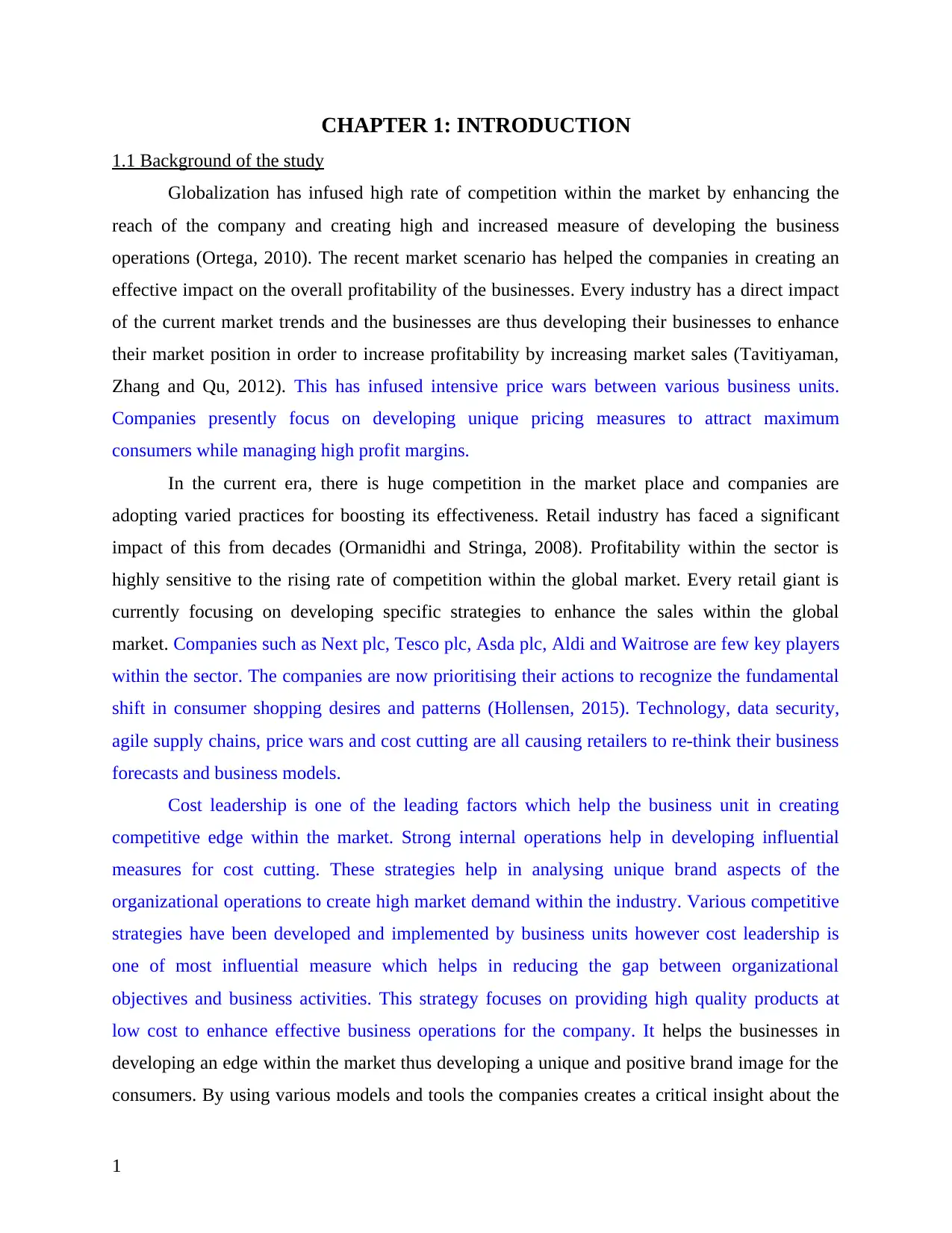
CHAPTER 1: INTRODUCTION
1.1 Background of the study
Globalization has infused high rate of competition within the market by enhancing the
reach of the company and creating high and increased measure of developing the business
operations (Ortega, 2010). The recent market scenario has helped the companies in creating an
effective impact on the overall profitability of the businesses. Every industry has a direct impact
of the current market trends and the businesses are thus developing their businesses to enhance
their market position in order to increase profitability by increasing market sales (Tavitiyaman,
Zhang and Qu, 2012). This has infused intensive price wars between various business units.
Companies presently focus on developing unique pricing measures to attract maximum
consumers while managing high profit margins.
In the current era, there is huge competition in the market place and companies are
adopting varied practices for boosting its effectiveness. Retail industry has faced a significant
impact of this from decades (Ormanidhi and Stringa, 2008). Profitability within the sector is
highly sensitive to the rising rate of competition within the global market. Every retail giant is
currently focusing on developing specific strategies to enhance the sales within the global
market. Companies such as Next plc, Tesco plc, Asda plc, Aldi and Waitrose are few key players
within the sector. The companies are now prioritising their actions to recognize the fundamental
shift in consumer shopping desires and patterns (Hollensen, 2015). Technology, data security,
agile supply chains, price wars and cost cutting are all causing retailers to re-think their business
forecasts and business models.
Cost leadership is one of the leading factors which help the business unit in creating
competitive edge within the market. Strong internal operations help in developing influential
measures for cost cutting. These strategies help in analysing unique brand aspects of the
organizational operations to create high market demand within the industry. Various competitive
strategies have been developed and implemented by business units however cost leadership is
one of most influential measure which helps in reducing the gap between organizational
objectives and business activities. This strategy focuses on providing high quality products at
low cost to enhance effective business operations for the company. It helps the businesses in
developing an edge within the market thus developing a unique and positive brand image for the
consumers. By using various models and tools the companies creates a critical insight about the
1
1.1 Background of the study
Globalization has infused high rate of competition within the market by enhancing the
reach of the company and creating high and increased measure of developing the business
operations (Ortega, 2010). The recent market scenario has helped the companies in creating an
effective impact on the overall profitability of the businesses. Every industry has a direct impact
of the current market trends and the businesses are thus developing their businesses to enhance
their market position in order to increase profitability by increasing market sales (Tavitiyaman,
Zhang and Qu, 2012). This has infused intensive price wars between various business units.
Companies presently focus on developing unique pricing measures to attract maximum
consumers while managing high profit margins.
In the current era, there is huge competition in the market place and companies are
adopting varied practices for boosting its effectiveness. Retail industry has faced a significant
impact of this from decades (Ormanidhi and Stringa, 2008). Profitability within the sector is
highly sensitive to the rising rate of competition within the global market. Every retail giant is
currently focusing on developing specific strategies to enhance the sales within the global
market. Companies such as Next plc, Tesco plc, Asda plc, Aldi and Waitrose are few key players
within the sector. The companies are now prioritising their actions to recognize the fundamental
shift in consumer shopping desires and patterns (Hollensen, 2015). Technology, data security,
agile supply chains, price wars and cost cutting are all causing retailers to re-think their business
forecasts and business models.
Cost leadership is one of the leading factors which help the business unit in creating
competitive edge within the market. Strong internal operations help in developing influential
measures for cost cutting. These strategies help in analysing unique brand aspects of the
organizational operations to create high market demand within the industry. Various competitive
strategies have been developed and implemented by business units however cost leadership is
one of most influential measure which helps in reducing the gap between organizational
objectives and business activities. This strategy focuses on providing high quality products at
low cost to enhance effective business operations for the company. It helps the businesses in
developing an edge within the market thus developing a unique and positive brand image for the
consumers. By using various models and tools the companies creates a critical insight about the
1
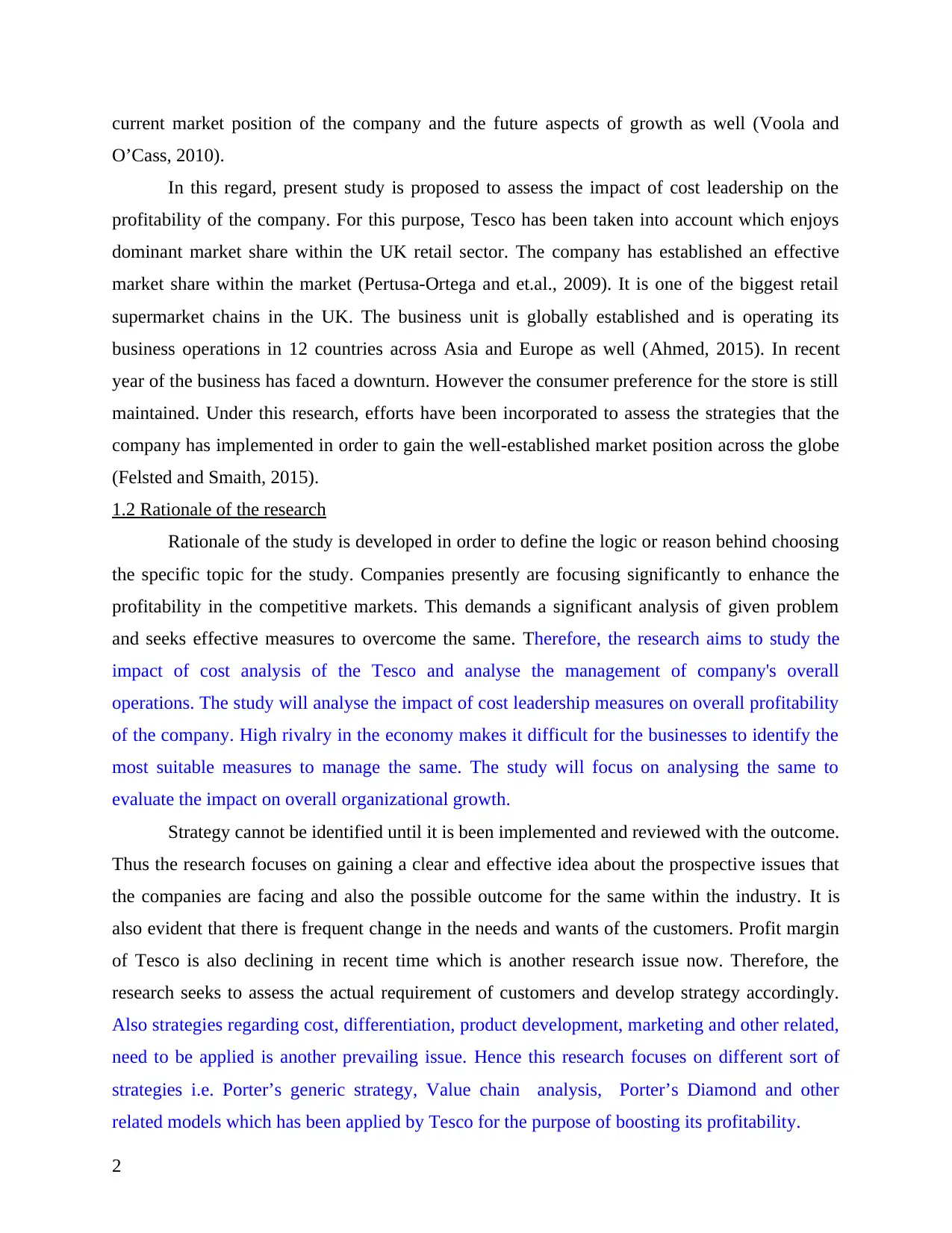
current market position of the company and the future aspects of growth as well (Voola and
O’Cass, 2010).
In this regard, present study is proposed to assess the impact of cost leadership on the
profitability of the company. For this purpose, Tesco has been taken into account which enjoys
dominant market share within the UK retail sector. The company has established an effective
market share within the market (Pertusa‐Ortega and et.al., 2009). It is one of the biggest retail
supermarket chains in the UK. The business unit is globally established and is operating its
business operations in 12 countries across Asia and Europe as well (Ahmed, 2015). In recent
year of the business has faced a downturn. However the consumer preference for the store is still
maintained. Under this research, efforts have been incorporated to assess the strategies that the
company has implemented in order to gain the well-established market position across the globe
(Felsted and Smaith, 2015).
1.2 Rationale of the research
Rationale of the study is developed in order to define the logic or reason behind choosing
the specific topic for the study. Companies presently are focusing significantly to enhance the
profitability in the competitive markets. This demands a significant analysis of given problem
and seeks effective measures to overcome the same. Therefore, the research aims to study the
impact of cost analysis of the Tesco and analyse the management of company's overall
operations. The study will analyse the impact of cost leadership measures on overall profitability
of the company. High rivalry in the economy makes it difficult for the businesses to identify the
most suitable measures to manage the same. The study will focus on analysing the same to
evaluate the impact on overall organizational growth.
Strategy cannot be identified until it is been implemented and reviewed with the outcome.
Thus the research focuses on gaining a clear and effective idea about the prospective issues that
the companies are facing and also the possible outcome for the same within the industry. It is
also evident that there is frequent change in the needs and wants of the customers. Profit margin
of Tesco is also declining in recent time which is another research issue now. Therefore, the
research seeks to assess the actual requirement of customers and develop strategy accordingly.
Also strategies regarding cost, differentiation, product development, marketing and other related,
need to be applied is another prevailing issue. Hence this research focuses on different sort of
strategies i.e. Porter’s generic strategy, Value chain analysis, Porter’s Diamond and other
related models which has been applied by Tesco for the purpose of boosting its profitability.
2
O’Cass, 2010).
In this regard, present study is proposed to assess the impact of cost leadership on the
profitability of the company. For this purpose, Tesco has been taken into account which enjoys
dominant market share within the UK retail sector. The company has established an effective
market share within the market (Pertusa‐Ortega and et.al., 2009). It is one of the biggest retail
supermarket chains in the UK. The business unit is globally established and is operating its
business operations in 12 countries across Asia and Europe as well (Ahmed, 2015). In recent
year of the business has faced a downturn. However the consumer preference for the store is still
maintained. Under this research, efforts have been incorporated to assess the strategies that the
company has implemented in order to gain the well-established market position across the globe
(Felsted and Smaith, 2015).
1.2 Rationale of the research
Rationale of the study is developed in order to define the logic or reason behind choosing
the specific topic for the study. Companies presently are focusing significantly to enhance the
profitability in the competitive markets. This demands a significant analysis of given problem
and seeks effective measures to overcome the same. Therefore, the research aims to study the
impact of cost analysis of the Tesco and analyse the management of company's overall
operations. The study will analyse the impact of cost leadership measures on overall profitability
of the company. High rivalry in the economy makes it difficult for the businesses to identify the
most suitable measures to manage the same. The study will focus on analysing the same to
evaluate the impact on overall organizational growth.
Strategy cannot be identified until it is been implemented and reviewed with the outcome.
Thus the research focuses on gaining a clear and effective idea about the prospective issues that
the companies are facing and also the possible outcome for the same within the industry. It is
also evident that there is frequent change in the needs and wants of the customers. Profit margin
of Tesco is also declining in recent time which is another research issue now. Therefore, the
research seeks to assess the actual requirement of customers and develop strategy accordingly.
Also strategies regarding cost, differentiation, product development, marketing and other related,
need to be applied is another prevailing issue. Hence this research focuses on different sort of
strategies i.e. Porter’s generic strategy, Value chain analysis, Porter’s Diamond and other
related models which has been applied by Tesco for the purpose of boosting its profitability.
2
⊘ This is a preview!⊘
Do you want full access?
Subscribe today to unlock all pages.

Trusted by 1+ million students worldwide
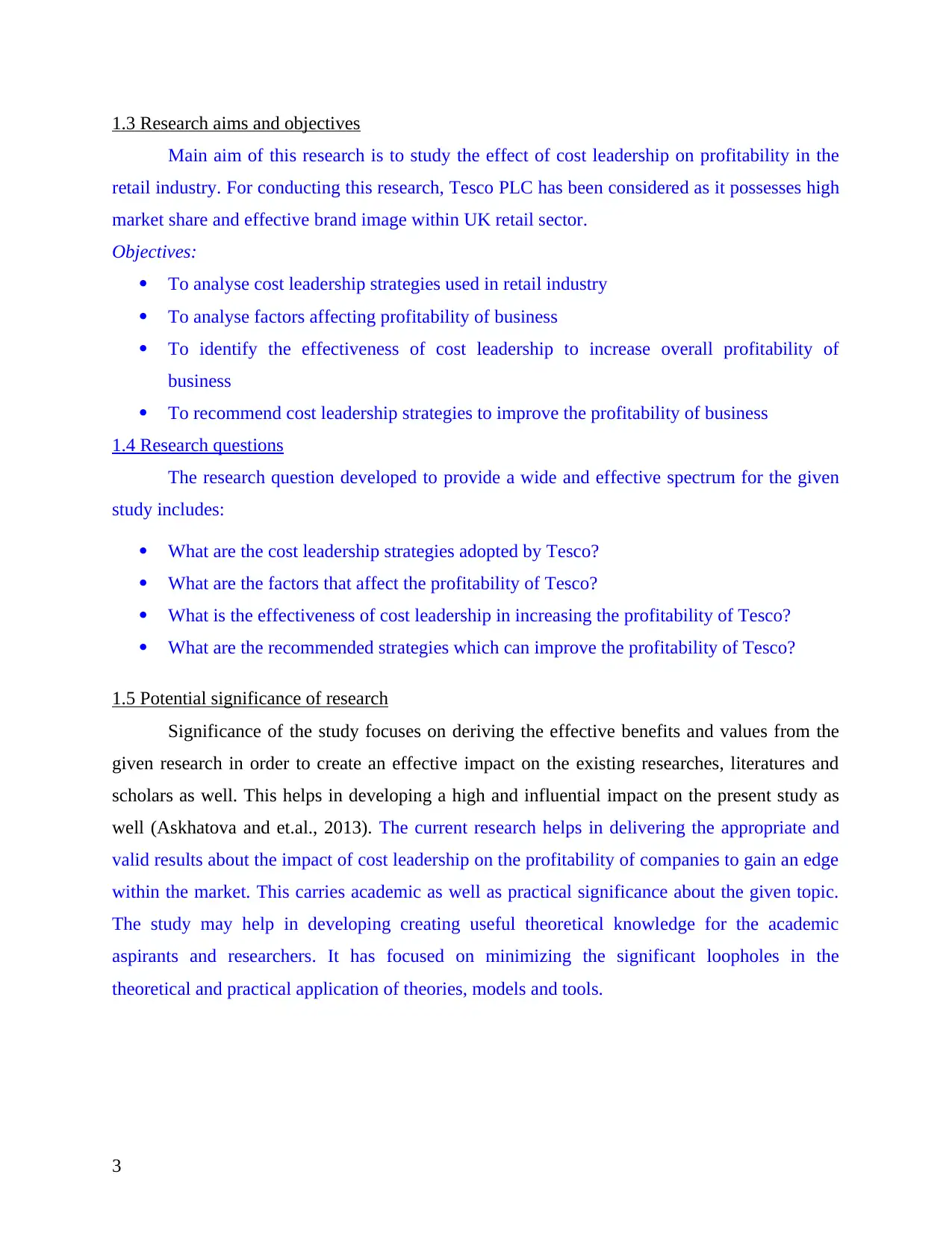
1.3 Research aims and objectives
Main aim of this research is to study the effect of cost leadership on profitability in the
retail industry. For conducting this research, Tesco PLC has been considered as it possesses high
market share and effective brand image within UK retail sector.
Objectives:
To analyse cost leadership strategies used in retail industry
To analyse factors affecting profitability of business
To identify the effectiveness of cost leadership to increase overall profitability of
business
To recommend cost leadership strategies to improve the profitability of business
1.4 Research questions
The research question developed to provide a wide and effective spectrum for the given
study includes:
What are the cost leadership strategies adopted by Tesco?
What are the factors that affect the profitability of Tesco?
What is the effectiveness of cost leadership in increasing the profitability of Tesco?
What are the recommended strategies which can improve the profitability of Tesco?
1.5 Potential significance of research
Significance of the study focuses on deriving the effective benefits and values from the
given research in order to create an effective impact on the existing researches, literatures and
scholars as well. This helps in developing a high and influential impact on the present study as
well (Askhatova and et.al., 2013). The current research helps in delivering the appropriate and
valid results about the impact of cost leadership on the profitability of companies to gain an edge
within the market. This carries academic as well as practical significance about the given topic.
The study may help in developing creating useful theoretical knowledge for the academic
aspirants and researchers. It has focused on minimizing the significant loopholes in the
theoretical and practical application of theories, models and tools.
3
Main aim of this research is to study the effect of cost leadership on profitability in the
retail industry. For conducting this research, Tesco PLC has been considered as it possesses high
market share and effective brand image within UK retail sector.
Objectives:
To analyse cost leadership strategies used in retail industry
To analyse factors affecting profitability of business
To identify the effectiveness of cost leadership to increase overall profitability of
business
To recommend cost leadership strategies to improve the profitability of business
1.4 Research questions
The research question developed to provide a wide and effective spectrum for the given
study includes:
What are the cost leadership strategies adopted by Tesco?
What are the factors that affect the profitability of Tesco?
What is the effectiveness of cost leadership in increasing the profitability of Tesco?
What are the recommended strategies which can improve the profitability of Tesco?
1.5 Potential significance of research
Significance of the study focuses on deriving the effective benefits and values from the
given research in order to create an effective impact on the existing researches, literatures and
scholars as well. This helps in developing a high and influential impact on the present study as
well (Askhatova and et.al., 2013). The current research helps in delivering the appropriate and
valid results about the impact of cost leadership on the profitability of companies to gain an edge
within the market. This carries academic as well as practical significance about the given topic.
The study may help in developing creating useful theoretical knowledge for the academic
aspirants and researchers. It has focused on minimizing the significant loopholes in the
theoretical and practical application of theories, models and tools.
3
Paraphrase This Document
Need a fresh take? Get an instant paraphrase of this document with our AI Paraphraser

1.6 Research structure
The current research study has developed an effective research structure in order to
develop an effective sequence for the study. This has helped in developing a clear understanding
and achieving the stated results. The structure of the present study is as follows: Chapter 1: Introduction- This chapter provide the clear understanding and background
of the given study. It creates an overall synopsis about various research tools and
techniques employed for developing required results. Chapter 2: Research Methodology- This section of the report creates an effective
understanding about the tools and techniques used to achieve the research objective. Chapter 3: Literature Review-This section of the report provides a detailed analysis of
past studies, researches, tools and models to resolve the research problem. It helps in
developing a clear understanding about the research related terms, terminologies, tools &
models and issues as well. Chapter 4: Data analysis-This section of the report has focused of the findings and
results that helped in analysing the facts and figures of the findings and create a broad
vision and critical analysis of the same.
Chapter 5: Conclusion and recommendations- This section of the report creates a clear
analysis of the overall report and evaluates the gap analysis for achieving the research
aim. It also provides the effective and practical suggestion to enhance the research topic
for developing most suitable strategies that Tesco may implement to enhance its
profitability.
4
The current research study has developed an effective research structure in order to
develop an effective sequence for the study. This has helped in developing a clear understanding
and achieving the stated results. The structure of the present study is as follows: Chapter 1: Introduction- This chapter provide the clear understanding and background
of the given study. It creates an overall synopsis about various research tools and
techniques employed for developing required results. Chapter 2: Research Methodology- This section of the report creates an effective
understanding about the tools and techniques used to achieve the research objective. Chapter 3: Literature Review-This section of the report provides a detailed analysis of
past studies, researches, tools and models to resolve the research problem. It helps in
developing a clear understanding about the research related terms, terminologies, tools &
models and issues as well. Chapter 4: Data analysis-This section of the report has focused of the findings and
results that helped in analysing the facts and figures of the findings and create a broad
vision and critical analysis of the same.
Chapter 5: Conclusion and recommendations- This section of the report creates a clear
analysis of the overall report and evaluates the gap analysis for achieving the research
aim. It also provides the effective and practical suggestion to enhance the research topic
for developing most suitable strategies that Tesco may implement to enhance its
profitability.
4

CHAPTER 2: RESEARCH METHODOLOGY
2.1 Introduction
Research methodology refers to methods and tools used to collect and analyse the data to
achieve the specific purpose. It essentially considers the concepts and theories which help in
using the underlying methods of developing a critical research study (Cooper and Schindler,
2011). Johnson and Christensen (2008) defined Research methodology as an approach which
considers the overall issues related to the evolution. It significantly revolves around a specific
research problem. The current research study creates a specific and clear impact on the impact of
cost leadership on overall profitability of the company to attain the research aim. This section
helps in developing a significant link between the research problem and methodologies in order
to achieve the specific research results.
2.2 Research philosophy
The research philosophies reflect the research methods that have been used in order to
conduct the present research. It helps the researcher in creating a deep insight about the research
problem thus developing an effective understanding about various factors that may help to
develop the possible solutions (Kimmel, 2009). It crucially consists of the research beliefs and
measures which may help the researcher in resolving the research problem. The three
terminologies that define the same are positivism, interpretivism and realism research
philosophies.
Interpretivism is a complex measure plays a crucial role in developing results from the
collected data (Jackson, 2010). The current study has used the interpretivism approach as the
data has been collected through secondary sources and has been analysed so as to create a clear
understanding of the given concepts. It has also help the researcher in developing a wide
understanding about the theories and models implemented in the research. The researcher has
self-interpreted the results as per the research problem. The competitive strategies used by the
business has been analysed for the study however the self-analysis through qualitative and
quantitative tools helped the researcher in attaining the set results. The positivism research
philosophy implements a well-structured method of to enable generalization of the views. This is
not applied for the study as it helps in evaluating the results on quantifiable measures.
5
2.1 Introduction
Research methodology refers to methods and tools used to collect and analyse the data to
achieve the specific purpose. It essentially considers the concepts and theories which help in
using the underlying methods of developing a critical research study (Cooper and Schindler,
2011). Johnson and Christensen (2008) defined Research methodology as an approach which
considers the overall issues related to the evolution. It significantly revolves around a specific
research problem. The current research study creates a specific and clear impact on the impact of
cost leadership on overall profitability of the company to attain the research aim. This section
helps in developing a significant link between the research problem and methodologies in order
to achieve the specific research results.
2.2 Research philosophy
The research philosophies reflect the research methods that have been used in order to
conduct the present research. It helps the researcher in creating a deep insight about the research
problem thus developing an effective understanding about various factors that may help to
develop the possible solutions (Kimmel, 2009). It crucially consists of the research beliefs and
measures which may help the researcher in resolving the research problem. The three
terminologies that define the same are positivism, interpretivism and realism research
philosophies.
Interpretivism is a complex measure plays a crucial role in developing results from the
collected data (Jackson, 2010). The current study has used the interpretivism approach as the
data has been collected through secondary sources and has been analysed so as to create a clear
understanding of the given concepts. It has also help the researcher in developing a wide
understanding about the theories and models implemented in the research. The researcher has
self-interpreted the results as per the research problem. The competitive strategies used by the
business has been analysed for the study however the self-analysis through qualitative and
quantitative tools helped the researcher in attaining the set results. The positivism research
philosophy implements a well-structured method of to enable generalization of the views. This is
not applied for the study as it helps in evaluating the results on quantifiable measures.
5
⊘ This is a preview!⊘
Do you want full access?
Subscribe today to unlock all pages.

Trusted by 1+ million students worldwide
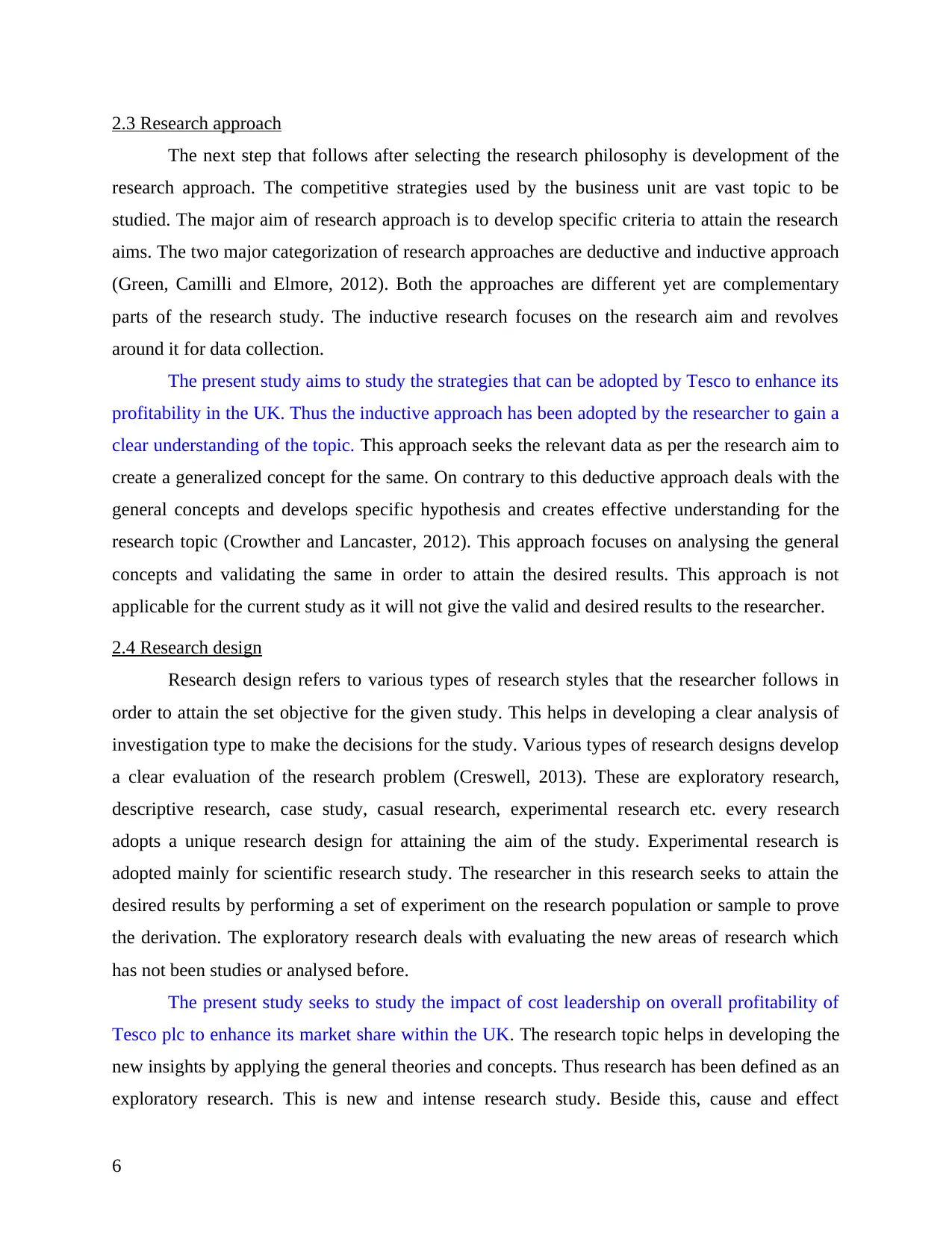
2.3 Research approach
The next step that follows after selecting the research philosophy is development of the
research approach. The competitive strategies used by the business unit are vast topic to be
studied. The major aim of research approach is to develop specific criteria to attain the research
aims. The two major categorization of research approaches are deductive and inductive approach
(Green, Camilli and Elmore, 2012). Both the approaches are different yet are complementary
parts of the research study. The inductive research focuses on the research aim and revolves
around it for data collection.
The present study aims to study the strategies that can be adopted by Tesco to enhance its
profitability in the UK. Thus the inductive approach has been adopted by the researcher to gain a
clear understanding of the topic. This approach seeks the relevant data as per the research aim to
create a generalized concept for the same. On contrary to this deductive approach deals with the
general concepts and develops specific hypothesis and creates effective understanding for the
research topic (Crowther and Lancaster, 2012). This approach focuses on analysing the general
concepts and validating the same in order to attain the desired results. This approach is not
applicable for the current study as it will not give the valid and desired results to the researcher.
2.4 Research design
Research design refers to various types of research styles that the researcher follows in
order to attain the set objective for the given study. This helps in developing a clear analysis of
investigation type to make the decisions for the study. Various types of research designs develop
a clear evaluation of the research problem (Creswell, 2013). These are exploratory research,
descriptive research, case study, casual research, experimental research etc. every research
adopts a unique research design for attaining the aim of the study. Experimental research is
adopted mainly for scientific research study. The researcher in this research seeks to attain the
desired results by performing a set of experiment on the research population or sample to prove
the derivation. The exploratory research deals with evaluating the new areas of research which
has not been studies or analysed before.
The present study seeks to study the impact of cost leadership on overall profitability of
Tesco plc to enhance its market share within the UK. The research topic helps in developing the
new insights by applying the general theories and concepts. Thus research has been defined as an
exploratory research. This is new and intense research study. Beside this, cause and effect
6
The next step that follows after selecting the research philosophy is development of the
research approach. The competitive strategies used by the business unit are vast topic to be
studied. The major aim of research approach is to develop specific criteria to attain the research
aims. The two major categorization of research approaches are deductive and inductive approach
(Green, Camilli and Elmore, 2012). Both the approaches are different yet are complementary
parts of the research study. The inductive research focuses on the research aim and revolves
around it for data collection.
The present study aims to study the strategies that can be adopted by Tesco to enhance its
profitability in the UK. Thus the inductive approach has been adopted by the researcher to gain a
clear understanding of the topic. This approach seeks the relevant data as per the research aim to
create a generalized concept for the same. On contrary to this deductive approach deals with the
general concepts and develops specific hypothesis and creates effective understanding for the
research topic (Crowther and Lancaster, 2012). This approach focuses on analysing the general
concepts and validating the same in order to attain the desired results. This approach is not
applicable for the current study as it will not give the valid and desired results to the researcher.
2.4 Research design
Research design refers to various types of research styles that the researcher follows in
order to attain the set objective for the given study. This helps in developing a clear analysis of
investigation type to make the decisions for the study. Various types of research designs develop
a clear evaluation of the research problem (Creswell, 2013). These are exploratory research,
descriptive research, case study, casual research, experimental research etc. every research
adopts a unique research design for attaining the aim of the study. Experimental research is
adopted mainly for scientific research study. The researcher in this research seeks to attain the
desired results by performing a set of experiment on the research population or sample to prove
the derivation. The exploratory research deals with evaluating the new areas of research which
has not been studies or analysed before.
The present study seeks to study the impact of cost leadership on overall profitability of
Tesco plc to enhance its market share within the UK. The research topic helps in developing the
new insights by applying the general theories and concepts. Thus research has been defined as an
exploratory research. This is new and intense research study. Beside this, cause and effect
6
Paraphrase This Document
Need a fresh take? Get an instant paraphrase of this document with our AI Paraphraser
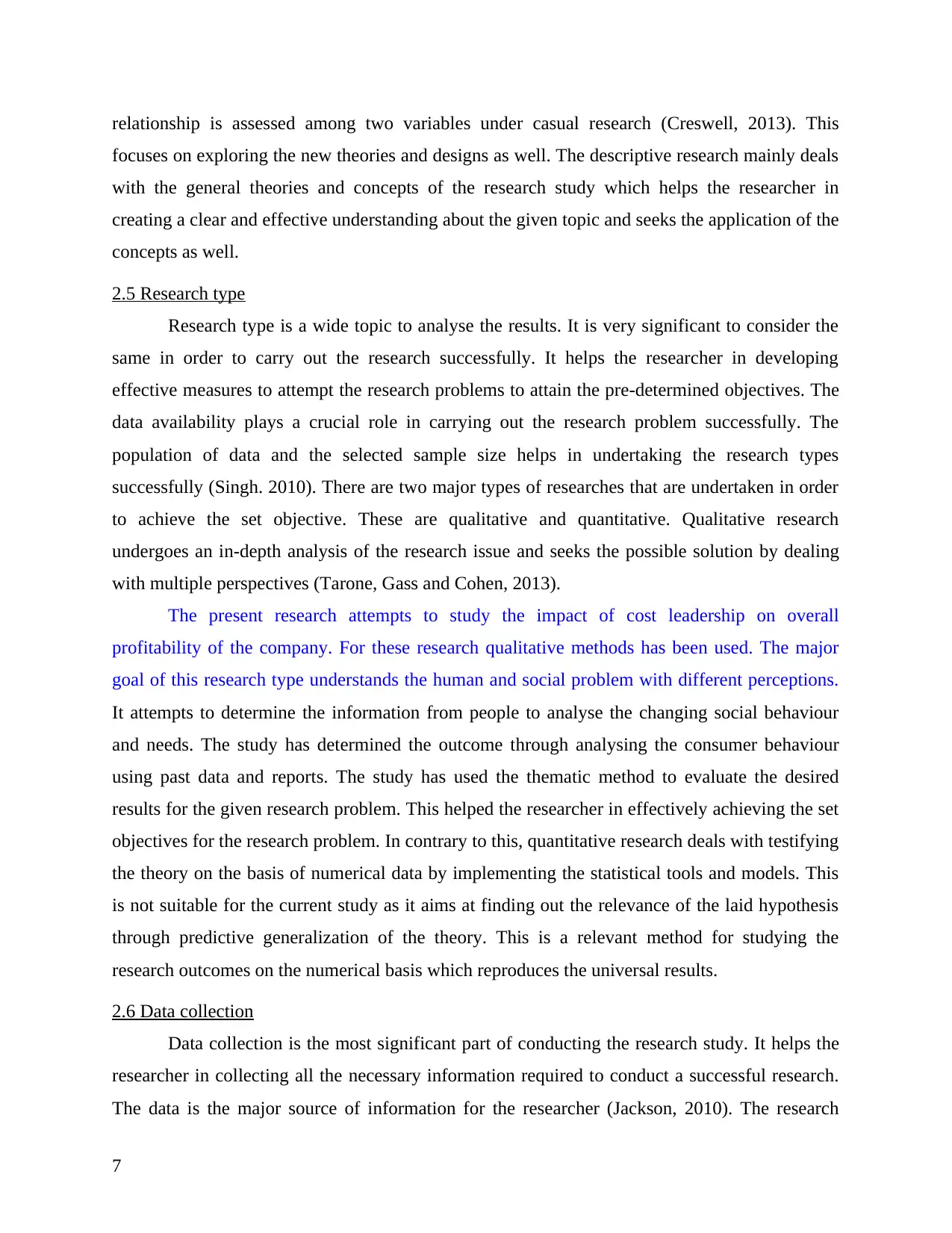
relationship is assessed among two variables under casual research (Creswell, 2013). This
focuses on exploring the new theories and designs as well. The descriptive research mainly deals
with the general theories and concepts of the research study which helps the researcher in
creating a clear and effective understanding about the given topic and seeks the application of the
concepts as well.
2.5 Research type
Research type is a wide topic to analyse the results. It is very significant to consider the
same in order to carry out the research successfully. It helps the researcher in developing
effective measures to attempt the research problems to attain the pre-determined objectives. The
data availability plays a crucial role in carrying out the research problem successfully. The
population of data and the selected sample size helps in undertaking the research types
successfully (Singh. 2010). There are two major types of researches that are undertaken in order
to achieve the set objective. These are qualitative and quantitative. Qualitative research
undergoes an in-depth analysis of the research issue and seeks the possible solution by dealing
with multiple perspectives (Tarone, Gass and Cohen, 2013).
The present research attempts to study the impact of cost leadership on overall
profitability of the company. For these research qualitative methods has been used. The major
goal of this research type understands the human and social problem with different perceptions.
It attempts to determine the information from people to analyse the changing social behaviour
and needs. The study has determined the outcome through analysing the consumer behaviour
using past data and reports. The study has used the thematic method to evaluate the desired
results for the given research problem. This helped the researcher in effectively achieving the set
objectives for the research problem. In contrary to this, quantitative research deals with testifying
the theory on the basis of numerical data by implementing the statistical tools and models. This
is not suitable for the current study as it aims at finding out the relevance of the laid hypothesis
through predictive generalization of the theory. This is a relevant method for studying the
research outcomes on the numerical basis which reproduces the universal results.
2.6 Data collection
Data collection is the most significant part of conducting the research study. It helps the
researcher in collecting all the necessary information required to conduct a successful research.
The data is the major source of information for the researcher (Jackson, 2010). The research
7
focuses on exploring the new theories and designs as well. The descriptive research mainly deals
with the general theories and concepts of the research study which helps the researcher in
creating a clear and effective understanding about the given topic and seeks the application of the
concepts as well.
2.5 Research type
Research type is a wide topic to analyse the results. It is very significant to consider the
same in order to carry out the research successfully. It helps the researcher in developing
effective measures to attempt the research problems to attain the pre-determined objectives. The
data availability plays a crucial role in carrying out the research problem successfully. The
population of data and the selected sample size helps in undertaking the research types
successfully (Singh. 2010). There are two major types of researches that are undertaken in order
to achieve the set objective. These are qualitative and quantitative. Qualitative research
undergoes an in-depth analysis of the research issue and seeks the possible solution by dealing
with multiple perspectives (Tarone, Gass and Cohen, 2013).
The present research attempts to study the impact of cost leadership on overall
profitability of the company. For these research qualitative methods has been used. The major
goal of this research type understands the human and social problem with different perceptions.
It attempts to determine the information from people to analyse the changing social behaviour
and needs. The study has determined the outcome through analysing the consumer behaviour
using past data and reports. The study has used the thematic method to evaluate the desired
results for the given research problem. This helped the researcher in effectively achieving the set
objectives for the research problem. In contrary to this, quantitative research deals with testifying
the theory on the basis of numerical data by implementing the statistical tools and models. This
is not suitable for the current study as it aims at finding out the relevance of the laid hypothesis
through predictive generalization of the theory. This is a relevant method for studying the
research outcomes on the numerical basis which reproduces the universal results.
2.6 Data collection
Data collection is the most significant part of conducting the research study. It helps the
researcher in collecting all the necessary information required to conduct a successful research.
The data is the major source of information for the researcher (Jackson, 2010). The research
7
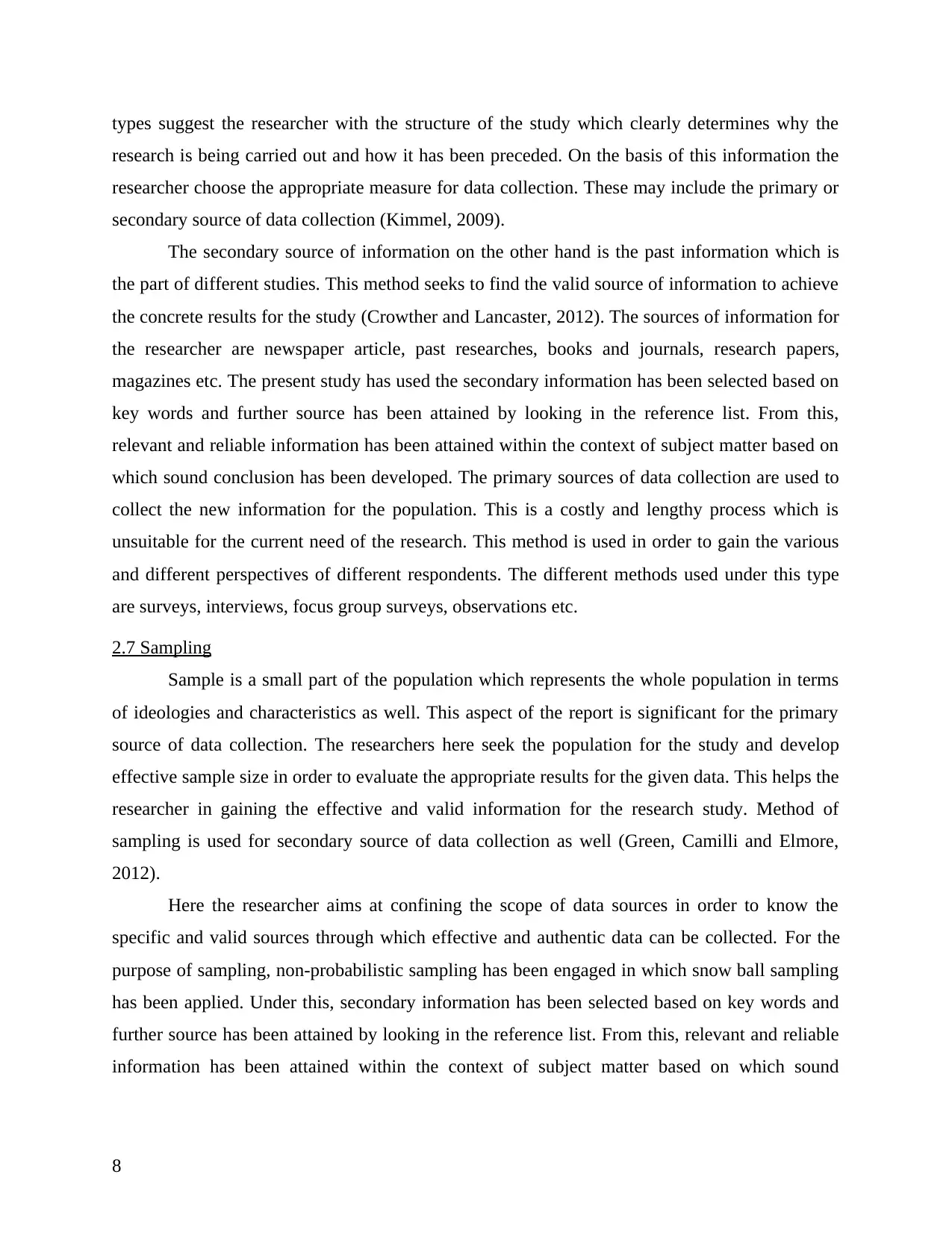
types suggest the researcher with the structure of the study which clearly determines why the
research is being carried out and how it has been preceded. On the basis of this information the
researcher choose the appropriate measure for data collection. These may include the primary or
secondary source of data collection (Kimmel, 2009).
The secondary source of information on the other hand is the past information which is
the part of different studies. This method seeks to find the valid source of information to achieve
the concrete results for the study (Crowther and Lancaster, 2012). The sources of information for
the researcher are newspaper article, past researches, books and journals, research papers,
magazines etc. The present study has used the secondary information has been selected based on
key words and further source has been attained by looking in the reference list. From this,
relevant and reliable information has been attained within the context of subject matter based on
which sound conclusion has been developed. The primary sources of data collection are used to
collect the new information for the population. This is a costly and lengthy process which is
unsuitable for the current need of the research. This method is used in order to gain the various
and different perspectives of different respondents. The different methods used under this type
are surveys, interviews, focus group surveys, observations etc.
2.7 Sampling
Sample is a small part of the population which represents the whole population in terms
of ideologies and characteristics as well. This aspect of the report is significant for the primary
source of data collection. The researchers here seek the population for the study and develop
effective sample size in order to evaluate the appropriate results for the given data. This helps the
researcher in gaining the effective and valid information for the research study. Method of
sampling is used for secondary source of data collection as well (Green, Camilli and Elmore,
2012).
Here the researcher aims at confining the scope of data sources in order to know the
specific and valid sources through which effective and authentic data can be collected. For the
purpose of sampling, non-probabilistic sampling has been engaged in which snow ball sampling
has been applied. Under this, secondary information has been selected based on key words and
further source has been attained by looking in the reference list. From this, relevant and reliable
information has been attained within the context of subject matter based on which sound
8
research is being carried out and how it has been preceded. On the basis of this information the
researcher choose the appropriate measure for data collection. These may include the primary or
secondary source of data collection (Kimmel, 2009).
The secondary source of information on the other hand is the past information which is
the part of different studies. This method seeks to find the valid source of information to achieve
the concrete results for the study (Crowther and Lancaster, 2012). The sources of information for
the researcher are newspaper article, past researches, books and journals, research papers,
magazines etc. The present study has used the secondary information has been selected based on
key words and further source has been attained by looking in the reference list. From this,
relevant and reliable information has been attained within the context of subject matter based on
which sound conclusion has been developed. The primary sources of data collection are used to
collect the new information for the population. This is a costly and lengthy process which is
unsuitable for the current need of the research. This method is used in order to gain the various
and different perspectives of different respondents. The different methods used under this type
are surveys, interviews, focus group surveys, observations etc.
2.7 Sampling
Sample is a small part of the population which represents the whole population in terms
of ideologies and characteristics as well. This aspect of the report is significant for the primary
source of data collection. The researchers here seek the population for the study and develop
effective sample size in order to evaluate the appropriate results for the given data. This helps the
researcher in gaining the effective and valid information for the research study. Method of
sampling is used for secondary source of data collection as well (Green, Camilli and Elmore,
2012).
Here the researcher aims at confining the scope of data sources in order to know the
specific and valid sources through which effective and authentic data can be collected. For the
purpose of sampling, non-probabilistic sampling has been engaged in which snow ball sampling
has been applied. Under this, secondary information has been selected based on key words and
further source has been attained by looking in the reference list. From this, relevant and reliable
information has been attained within the context of subject matter based on which sound
8
⊘ This is a preview!⊘
Do you want full access?
Subscribe today to unlock all pages.

Trusted by 1+ million students worldwide
1 out of 46
Related Documents
Your All-in-One AI-Powered Toolkit for Academic Success.
+13062052269
info@desklib.com
Available 24*7 on WhatsApp / Email
![[object Object]](/_next/static/media/star-bottom.7253800d.svg)
Unlock your academic potential
Copyright © 2020–2025 A2Z Services. All Rights Reserved. Developed and managed by ZUCOL.





